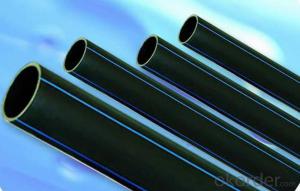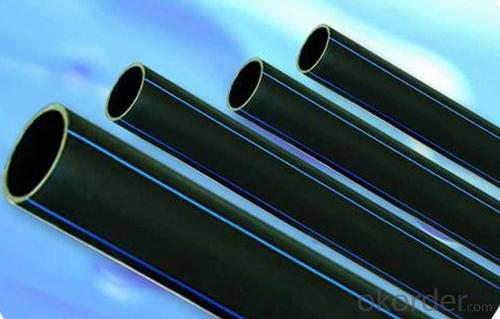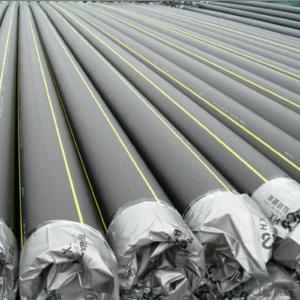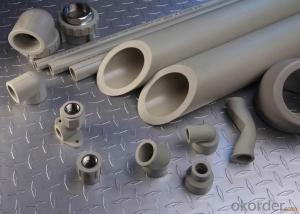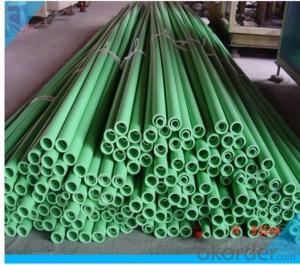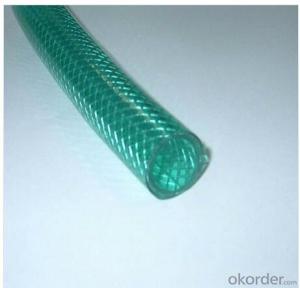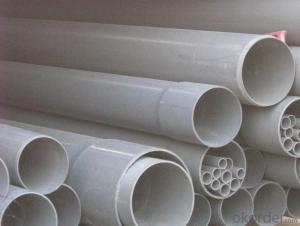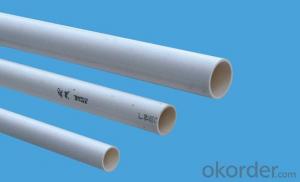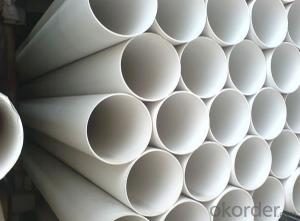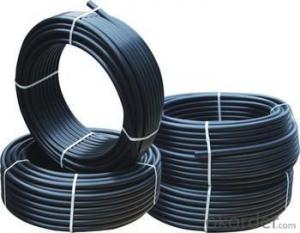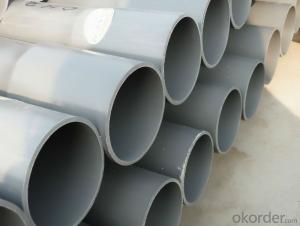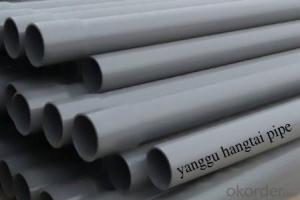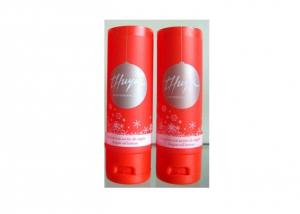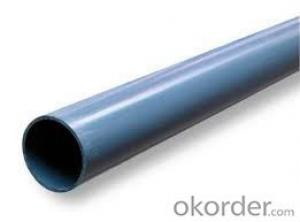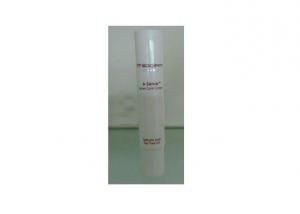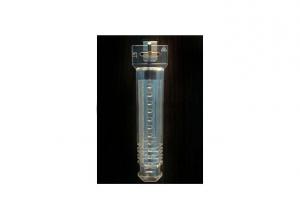HDPE Plastic Tubes ISO4427-1996
- Loading Port:
- China Main Port
- Payment Terms:
- TT OR LC
- Min Order Qty:
- -
- Supply Capability:
- -
OKorder Service Pledge
OKorder Financial Service
You Might Also Like
Physical properties[edit]
Polyethylene is a thermoplasticpolymer consisting of long hydrocarbon chains. Depending on the crystallinity and molecular weight, a melting point and glass transition may or may not be observable. The temperature at which these occur varies strongly with the type of polyethylene. For common commercial grades of medium- and high-density polyethylene the melting point is typically in the range 120 to 180 °C (248 to 356 °F). The melting point for average, commercial, low-density polyethylene is typically 105 to 115 °C (221 to 239 °F).it is transprant.
Chemical properties[edit]
Most LDPE, MDPE and HDPE grades have excellent chemical resistance, meaning that it is not attacked by strong acids or strong bases. It is also resistant to gentle oxidants and reducing agents. Polyethylene burns slowly with a blue flame having a yellow tip and gives off an odour of paraffin. The material continues burning on removal of the flame source and produces a drip.[3] Crystalline samples do not dissolve at room temperature. Polyethylene (other than cross-linked polyethylene) usually can be dissolved at elevated temperatures in aromatic hydrocarbons such as toluene or xylene, or in chlorinated solvents such as trichloroethane or trichlorobenzene.[4]
GB/T13663-2000:
| PE63管材规格 | |||||
| 公称 外径dn,mm | SDR33 | SDR26 | SDR17.6 | SDR13.6 | SDR11 |
| 公称压力 PN,Mpa | |||||
| 0.32 | 0.4 | 0.6 | 0.8 | 1.0 | |
| 公称 壁厚 | 公称 壁厚 | 公称 壁厚 | 公称 壁厚 | 公称 壁厚 | |
| 16 | 2.3 | ||||
| 20 | 2.3 | 2.3 | |||
| 25 | 2.3 | 2.3 | 2.3 | ||
| 32 | 2.3 | 2.4 | 2.9 | ||
| 40 | 2.3 | 2.3 | 3.0 | 3.7 | |
| 50 | 2.3 | 2.9 | 3.7 | 4.6 | |
| 63 | 2.3 | 2.5 | 3.6 | 4.7 | 5.8 |
| 75 | 2.3 | 2.9 | 4.3 | 5.6 | 6.8 |
| 90 | 2.8 | 3.5 | 5.1 | 6.7 | 8.2 |
| 110 | 3.4 | 4.2 | 6.3 | 8.1 | 10.0 |
| 125 | 3.9 | 4.8 | 7.1 | 9.2 | 11.4 |
| 140 | 4.3 | 5.4 | 8.0 | 10.3 | 12.7 |
| 160 | 4.9 | 6.2 | 9.1 | 11.8 | 14.6 |
| 180 | 5.5 | 6.9 | 10.2 | 13.3 | 16.4 |
| 200 | 6.2 | 7.7 | 11.4 | 14.7 | 18.2 |
| 225 | 6.9 | 8.6 | 12.8 | 16.6 | 20.5 |
| 250 | 7.7 | 9.6 | 14.2 | 18.4 | 22.7 |
| 280 | 8.6 | 10.7 | 15.9 | 20.6 | 25.4 |
| 315 | 9.7 | 12.1 | 17.9 | 23.2 | 28.6 |
| 355 | 10.9 | 13.6 | 20.1 | 26.1 | 32.2 |
| 400 | 12.3 | 15.3 | 22.7 | 29.4 | 36.3 |
| 450 | 13.8 | 17.2 | 25.5 | 33.1 | 40.9 |
| 500 | 15.3 | 19.1 | 28.3 | 36.8 | 45.4 |
| 560 | 17.2 | 21.4 | 31.7 | 41.2 | 50.8 |
| 630 | 19.3 | 24.1 | 35.7 | 46.3 | 57.2 |
- Q: Are plastic tubes suitable for freezing temperatures?
- Yes, plastic tubes are generally suitable for freezing temperatures.
- Q: Is the electric pipe used with steel pipe or PVC pipe?
- When the electric wire pipe is laid, the steel pipe can be adopted, or the plastic pipe can be adopted, but the steel tube must not be used in the ceiling. The standard explanation is for rat bite.
- Q: it is too short as it allows water backup from my discharge pipe. does anyone have any idea's how I can extend my gooseneck deeper into my discharge pipe so water does not back up?and no, I do not have a blockage. my plumber told me my washer discharge gooseneck is too short. it needs to go 8 to a foot into pipe.
- Normally the plastic part that forms the n shaped bend can be unclipped and moved up the hose so you can get a longer length into the discharge stand pipe. If the pipe is too short to reach the stand pipe when you do this, you can buy an extension kit from a hardware store.
- Q: Do plastic tubes have any UV resistance?
- Yes, plastic tubes can have varying degrees of UV resistance depending on the type of plastic used. Some plastics, such as PVC and acrylic, are naturally UV resistant, while others may require the addition of UV stabilizers to enhance their resistance to UV radiation.
- Q: has anyone had the die test done to check your tube? if so please share you story?
- Yes, and I don't want to scare you, but for me, it really really hurt. First they use a larger than normal speculum to hold your vagina open so they can see what they're doing. Then they use a swab with iodine to sterilize the cervix. Then they insert a long handled hemostat to pinch the edge of your uterus to hold it still so they can put the little tube in there. Then comes the super ouchy part, where they thread a little plastic tube into the cervix. I have heard some women say it was no big deal, and some say it didn't even hurt, but for me, it was horrible. Like a bad PMS cramp times a million. Like someone stabbed me in the uterus with a butcher knife. Then the little x-ray guy runs in, and pushes the dye through the tube, and looks at it in a monitor, which was pretty neat, bc I could see it on the monitor, and that kind of stuff fascinates me. Then the x-ray guy runs out, and my gyne pulled the whole fandangle out. He was going slowly, trying to be gentle, and I was like, I don't care! Just get this junk out of me!! But, on the bright side, the painful part lasted about 30 seconds. So don't stress too much. Even if you're one of the women for whom it will be painful, it is over very quickly. Good luck!
- Q: Are plastic tubes suitable for hydrostatic pressure testing?
- Yes, plastic tubes are suitable for hydrostatic pressure testing.
- Q: Can plastic tubes be used for solar panel installations?
- Yes, plastic tubes can be used for certain aspects of solar panel installations, such as protecting and routing electrical wiring or as a conduit for water or coolant circulation. However, plastic tubes are not typically used as the primary material for the solar panels themselves, as they lack the necessary properties to efficiently convert sunlight into electricity.
- Q: Are plastic tubes recyclable?
- Yes, plastic tubes are recyclable. However, it is important to check with your local recycling facility to ensure that they accept plastic tubes for recycling, as some facilities may have specific guidelines or limitations.
- Q: What are the advantages of using plastic tubes in the pharmaceutical packaging industry?
- There are several advantages of using plastic tubes in the pharmaceutical packaging industry. Firstly, plastic tubes provide excellent protection against moisture, light, and oxygen, ensuring the stability and integrity of pharmaceutical products. Secondly, plastic tubes are lightweight and portable, making them convenient for patients to carry and use. Additionally, plastic tubes are easy to squeeze and dispense the correct dosage, enhancing patient compliance. Furthermore, plastic tubes can be produced in various sizes and shapes, allowing for flexible packaging options. Lastly, plastic tubes are cost-effective and can be easily mass-produced, making them a cost-efficient choice for pharmaceutical companies.
Send your message to us
HDPE Plastic Tubes ISO4427-1996
- Loading Port:
- China Main Port
- Payment Terms:
- TT OR LC
- Min Order Qty:
- -
- Supply Capability:
- -
OKorder Service Pledge
OKorder Financial Service
Similar products
Hot products
Hot Searches
Related keywords
